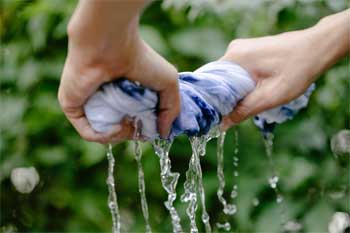
Some fabrics, especially delicate fabrics such as silk, wool, chiffon and lace, are more sensitive to cold water and freezing temperatures than others. Different fabrics have varying properties and care requirements, and exposure to extreme cold can affect their appearance, texture, and durability. Here are a few examples of fabrics that may be more sensitive to cold water or freezing temperatures:
Silk
Silk is a delicate and natural fiber that can be sensitive to extreme cold. Cold water can cause silk to become brittle and lose its natural sheen. Freezing temperatures can potentially damage silk fibers, leading to breakage and a loss of fabric integrity.
Wool

While wool is known for its warmth, it can also be sensitive to freezing temperatures when wet. Wet wool can become heavy and stretched out of shape when frozen. Rapid temperature changes can also cause wool fibers to contract and become misshapen. To care for wool during winter, opt for hand washing or a delicate cycle with cold water and a mild detergent. When drying, lay the wool flat on a towel, reshape it, and avoid hanging to prevent stretching. Opt for well-ventilated areas during the drying process, steering clear of direct heat sources such as a heater, or radiator. Patience is crucial, as wool takes longer to dry compared to other fabrics. Once dry, store your wool items in a cool, dry place, using breathable garment bags to protect them from dust and moths. Following these steps will help maintain the quality and appearance of your wool garments during the winter months.
Cashmere
Cashmere is a luxurious and soft natural fiber derived from the hair of goats. Similar to wool, cashmere can lose its shape and texture when exposed to freezing temperatures while wet. Care should be taken to properly dry cashmere items in a controlled environment.
Rayon
Rayon is a semi-synthetic fiber that can lose its strength and shape when exposed to cold water. It’s recommended to follow care instructions and avoid subjecting rayon fabrics to extreme temperature changes.

Leather and Suede

Caring for leather and suede involves considerations regarding exposure to water and freezing temperatures. In the case of natural, unfinished leather, water can lead to stiffness, discoloration, and potential cracking by depleting its natural oils. For suede, a type of leather with a napped finish, water is particularly problematic, causing stains and altering the texture. It is advisable to let wet leather items air-dry at room temperature, avoiding heat sources. Additionally, extreme cold can make leather more brittle, potentially leading to cracking, though many leather items can withstand normal winter temperatures. Suede, when exposed to freezing temperatures, may become stiff, and its nap can be affected. Using a suede brush to restore the texture is recommended. Applying preventative measures such as leather protectors or waterproofing sprays and following proper storage practices, including avoiding extreme temperature fluctuations, can help maintain the integrity of both leather and suede items. Cleaning stains promptly and adhering to manufacturer care instructions tailored to the specific type and finish of the material are essential for effective care.
Elastic Materials
Fabrics with elastic components, like Spandex or Elastane, can be affected by extreme cold. Freezing temperatures can cause these materials to lose elasticity and stretch out of shape.
Delicate Lace
Delicate lace fabrics can become more fragile when wet and exposed to cold temperatures. Handling wet lace roughly or freezing it can lead to tearing and damage.
Synthetic Blends
Some synthetic fabrics or blends can be more sensitive to cold water or freezing temperatures depending on their composition. It’s a good idea to check the care labels and manufacturer recommendations for such fabrics.
When dealing with sensitive fabrics in cold weather:
- Check Care Labels: Always check the care labels and manufacturer recommendations for specific care instructions related to water temperature and drying methods.
- Hand Washing: If you need to wash delicate fabrics in cold water, consider hand washing them carefully instead of subjecting them to machine agitation.
- Air Drying: Whenever possible, air dry sensitive fabrics indoors using gentle methods, such as drying racks or laying them flat on a clean towel.
- Avoid Extreme Conditions: If you live in an area with harsh winter conditions, it’s best to avoid exposing delicate fabrics to freezing temperatures whenever possible.
By being mindful of the care requirements of different fabrics and adapting your laundry routine accordingly, you can help preserve the quality and longevity of your clothing items.
[…] Some fabrics may be more sensitive to cold water or freezing temperatures. Read clothing labels for any specific care instructions, and avoid washing delicate items in very cold water. […]